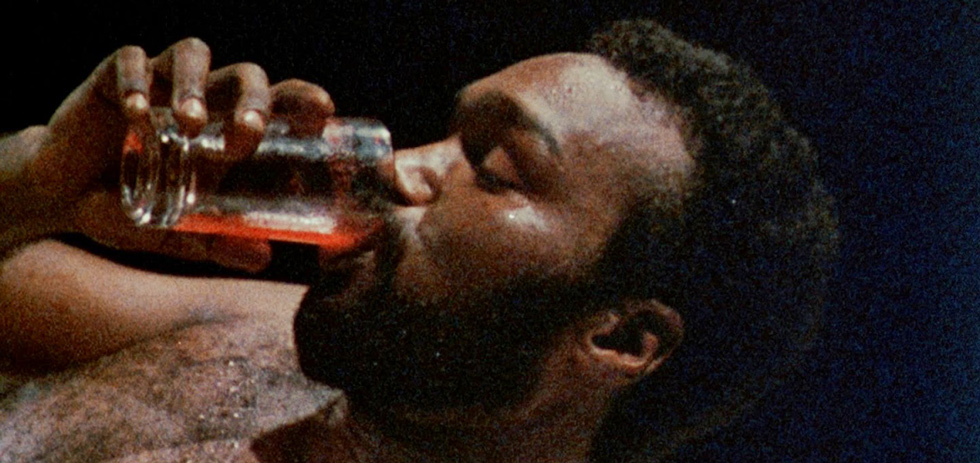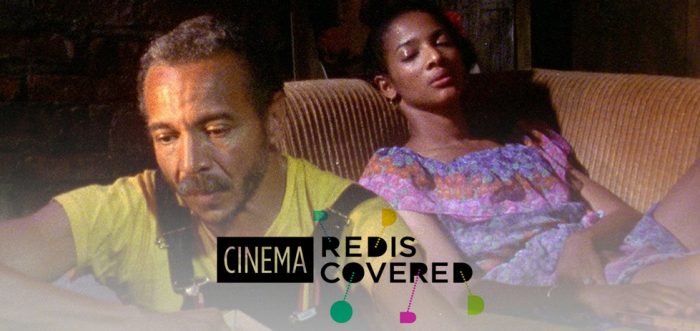With the launch of the inaugural Cinema Rediscovered, an archive and classic film festival in Bristol, England, we are presenting a series of pieces on the screening program. In this piece, Tara Judah, a Curator for the festival, looks at two films that played at the festival, Kathleen Collins’ Losing Ground and Bill Gunn’s Ganja & Hess.
Tara’s previous piece in this series, on Anthony Harvey’s Dutchman, can be read here.
Sara (Seret Scott) is standing almost entirely out of frame and yet we know she’s in the room because we can just about make out the edge of her outfit on the far right side of the screen. Everyone else in the room is actively participating in the scene. Her husband Victor (Bill Gunn) is shouting; his intention is to put her down in front of their guests but he is so crass about it that he’s upsetting them, too. No one is having a nice time, though they are supposedly at a party and, right now, supposed to be dancing. Sara takes a step to her left until she is directly in front of the camera, but with her back to the viewer. Suddenly, her figures fills most of the frame, yet she is unable to command the space onscreen. Her husband Victor, their guests Duke (Duane Jones) and Celia (Maritza Rivera) appear to be uncomfortable but the true impact of Sara’s gaze is immeasurable for the viewer: we are not subject to her gaze and therefore can only see her as the shape of intervention, not the face of it.
Kathleen Collins’ Losing Ground (1982) has rarely been seen. It is hailed as one of the first films to be directed by an African-American woman but never found its audience in Collins’ lifetime – the film didn’t receive a theatrical release and Collins died in 1988 from breast cancer. Supporting actor Bill Gunn, who was a writer and director in his own right, died just one year later, in 1989, from encephalitis. Gunn’s Ganja & Hess (1973) screened at Bristol’s inaugural Cinema Rediscovered in July, in a strand curated by Karen Alexander in partnership with Autograph ABP.1 Two remarkable African-American filmmakers and important black independent cinema voices tragically quietened.
The absence of these films from our film history screens and schools makes me wonder about what else is missing from our understanding of American Independent Cinema from the 1970s and 1980s. It’s a crucial period of continuation between American Underground and Beat cinema of the 1960s and late 1950s and the quirky indie mumblecore of the 1990s and 2000s. Thankfully, Milestone Films have made Losing Ground available, in cinemas and on home entertainment format.2 In the UK, the Independent Cinema Office (ICO) are now touring the film, a title that has reportedly influenced the likes of Julie Dash and Charles Burnett.
Losing Ground is important as a milestone for women in front of the camera as well as behind it. Made after eleven years of Blaxploitation, the role of Sara was anomalous: a middle-class university professor on the verge of publishing a new book, thrust into an exciting low budget acting career, married to an avant-garde painter/portrait artist. Sara is also dealing with the perception of her identity as attached to her husband’s. All of this is a catalyst for a period of self-actualisation that involves meeting an attractive, intelligent man in a cape. Yep, definitely an anomaly back in 1982 – probably still an anomaly now. That there were very few central roles for black women that had anything to do with the experience of being a black woman in America at that time makes the re-release of this film today as significant as it is entertaining.
Every step of the way I was gunning for Sara to stand up to Victor and to take what’s hers – and, in a rare experience of joy when watching women protagonists in film, I was fist pumping all over the place when she did.
British writer and curator Karen Alexander, who introduced the screening, also talked about bell hooks’ writing on ‘the oppositional gaze’ and the active intervention and interrogation of the image that frees up black female spectatorship. That is to say that the film has a unique way of addressing what’s in the frame so that the audience can free themselves from trained modes of viewing. In one spectacular and very meta sequence (for an indie film made in 1982), Sara, acting in a film within the film, tells her co-star, who is also acting in the film within the film, that the purpose of the scene is, “Something to do with the relationship between the characters and the space, the light.” Collins is aware that her film is a refreshing and straight-up perspective on well-drawn characters, the politics and heat of 1980s New York city and the light under which we view it all.

In Gunn’s Ganja & Hess, a film about vampires, but also a film about addiction, politics, religion and black class, we see some of the same important faces from this period of African American independent cinema. Both Duane Jones (Dr Hess Green) and Bill Gunn (George Meda) are back on screen. Here, as with Losing Ground, the two characters are played off one another in a kind of machismo competition that is at once a fight for survival but also a fight for a woman, George’s wife Ganja (Marlene Clark). Admittedly this fight for Ganja is somewhat unwitting on Hess’s part, but the causal nature of events and macho addiction still leads to the prize of a female mate.
What struck me most about Gunn’s social commentary housed under the Blaxploitation banner is its visceral intensity. The film’s score is like a painfully fluttering heartbeat, its rapid rhythm hits like the moment of withdrawal and its low dirge persists like comedown. The blend of African tribal chanting, strong beats, echoing vocal effects and the ghostly sounds of mocking laughter make each of the feasting frenzies Hess, and later Ganja, participate in completely shocking and utterly guttural.
Again, Ganja & Hess is a film that’s had a hard time finding its audience. Though it screened at the Critics Week in Cannes in 1973 and was remade by Spike Lee in 2014, under the title Da Sweet Blood of Jesus, it did poorly at the box office and its unusual structure and style led its producers to withdraw it from distribution and sell it to another company who released it drastically recut under the new title Blood Couple. VHS versions of this film vary but it wasn’t until the original cut, on a stunning 35mm film print, was donated to New York’s Museum of Modern Art that the film found a new reputation as Chris Fujiwara rightly called it “a neglected classic of independent African American cinema”.
Losing Ground, Ganja & Hess, Dutchman and still/here are like lost pieces of a jigsaw, finally put into place. They are crucial to our understanding of American independent filmmaking and they tell black stories that have been missing in our history. But as these pieces click into place the shape and the parameters of the puzzle change. Even as we gain a little ground, great swathes of it remain lost.
